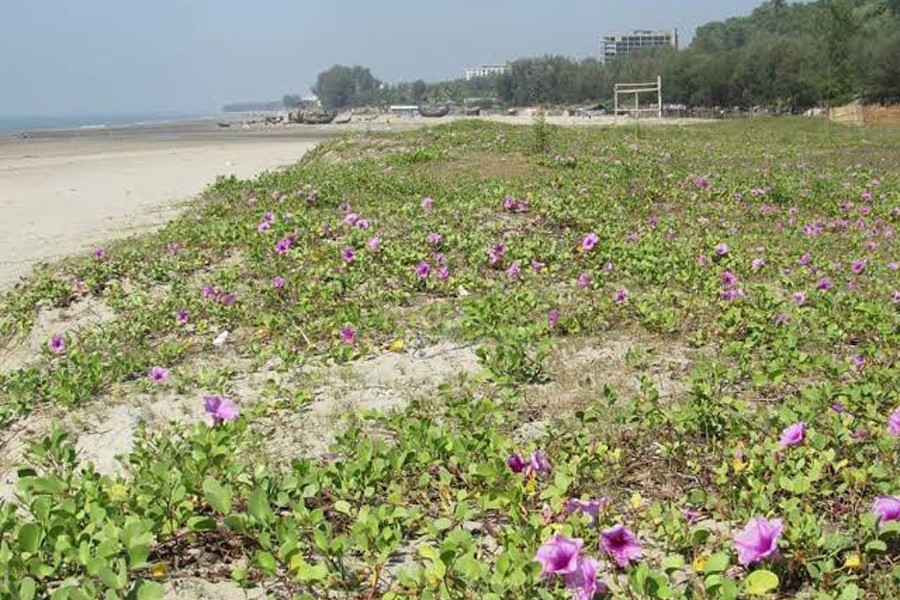
Seaweeds protect sand dunes of Cox's Bazar beach
Sand dunes in country's sea beaches are rich with rare minerals, uranium
A CORRESPONDENT | Monday, 1 November 2021

COX'S BAZAR: Rare minerals, including uranium, can be formed around the seaweeds of the Cox's Bazar beach. Its local name is Daungalta or Pinya Lata. The plant is also known as the 'sand maker' because it builds large sand dunes on the beach to prevent soil erosion and dry flying sand. The sand dunes of the beach are rich in uranium and other rare minerals.
According to the researchers, the cultivation of seaweed on Cox's Bazar beach can create endless reserves of valuable mineral resources. Scientists believe that this could also create a new possibility in the blue-economy.
Uranium is a naturally occurring heavy metal that has been used for hundreds of years as an abundance of concentrated energy. Uranium is the main fuel for nuclear reactors.
According to scientists, one kg of uranium can generate about 24 million units of electricity. But only 12 units of electricity can be generated from one kg of fuel oil, and only 8 units from one kg of coal. In other words, the energy of uranium is two million to three million times more than the energy of oil or coal.
Former geologist of Bangladesh Atomic Energy Commission and National Poet Nazrul Islam University Professor Ashraf Ali Siddiqui said a recent test of the groundwater and water on Cox's Bazar beach found high levels of nuclear reactor fuel or uranium.
Monazite in the mineral sand of the beach contains about 16 per cent uranium. Maheshkhali-Kutubdia and Kuakata have the same topography as Cox's Bazar. This indicates that there are valuable minerals in the sand dunes of our beach. If the ocean can create dunes, it can be said that it can build reserves of rare minerals, including uranium. Monazite found on Cox's Bazar beach contains uranium-thorium as well as rare minerals (RAEM), he said.
The 18 rare minerals in the world are called 'Rare Earth Material / Element' or REM / REE. The substances are Cerium (code name CE), Dysprosium (DY), Erbium (ER), Europium (EU), Gadulinium (GD), Halmium (HO), Lanthanum (LA), Lutetium (LU), Neodymium (ND), Presidium (PR), Promethium (PM), Samarium (SM), Scandium (SC), Tarbium (TB), Thulium (TM), Itterbium (YB) and Itterium (Y). The former geologist of the Bangladesh Atomic Energy Commission thinks that all the elements exist in the country.
Ashraf Ali Siddiqui said the lanthanide (LN) series, which has already been found in the mineral sand of the beach, has the presence of rare minerals including lanthanum (LA). So it is certain that we also have REM in our country.
Production of 'rare earth metals' (known as REM or REE) used in high technology, including renewable energy and the safety of nuclear reactors, is on the rise worldwide. Even Myanmar joined the list of rare metal producing countries in 2016, overtaking Russia-India and occupying the fourth top spot in the world in two years. However, the Indian subcontinent is estimated to have one-third of the world's rare earth reserves.
The country's senior nuclear scientist, former director of the Atomic Energy Commission. Mir Qasim said heavy mineral sand was explored in 1985 in the 550- km long coastal region of Bangladesh.
Geological survey found 6 valuable minerals out of 16 piles. Apart from Cox's Bazar beach, there are sand dunes at Inani, Shahparirdwip, Maheshkhali, Kutubdia and Kuakata Island.
A research report published in the world-famous science journal ScienceDirect.com (mouthpiece of Groundwater for Sustainable Development) on January 9 last year revealed high levels of uranium in zircon and monazite in the subsoil of Cox's Bazar. However, scientists believe that we can use different plants and animals as a simple and sustainable technology to extract those resources.
Chittagong University Institute of Environment and Forestry Professor Kamal Hossain said sand dunes are created on the beach through Sagaralta. If there are valuable minerals in the sand dunes, it means that the oceans are bringing in those resources. In this way, if we can calculate the multifaceted functionality of our plants in nature, then we can benefit the society and the state by using it.
An ocean can be more than 100 feet long. Sand dunes are created through the afforestation of the sea to restore the environment of the developed world beaches. In the way shown by them, the locals have been able to create sand dunes through the afforestation of Sagaralta in Darianagar, a suburb of Cox's Bazar.
Scientists at the Bangladesh Atomic Energy Commission's Cox's Bazar Mineral Sand Mining Center believe that there are 120-km of beach in Cox's Bazar, Maheshkhali, Kutubdia, and a huge sand dune on St. Martin's Island.
Apart from uranium, there are 16-21 types of mineral sand including zircon and monazite. All these mineral sands are called sand or black gold. The research team thinks that if mineral sand is extracted in a planned manner, it will be possible to reduce the dependence on imports from abroad as raw material for making various electronic materials and weapons.